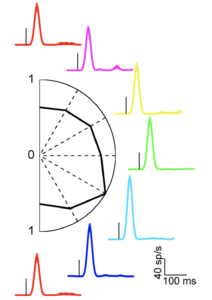 We have a new paper in press at Frontiers in Neural Circuits! The paper is part of a Special Research Topic on “The Superior Colliculus/Tectum: Cell Types, Circuits, Computations, and Behaviors”.
We have a new paper in press at Frontiers in Neural Circuits! The paper is part of a Special Research Topic on “The Superior Colliculus/Tectum: Cell Types, Circuits, Computations, and Behaviors”.
Our study complements this one and this one from our lab, and it continues our efforts to explore the visual processing properties of the primate superior colliculus (SC). Historically, the SC in monkeys has been studied primarily from the perspective of saccade control. Therefore, visual stimuli were considered mere guide posts for guiding saccades, and they were thus often simple, minimalist spots of light. However, the SC is very much a visual structure, and we have an interest in exploring its visual properties.
In our study, we described orientation tuning in primate SC neurons; in other words, would these neurons preferentially respond to edges of a particular orientation? If so, this means that the SC can help in coarse pattern analysis (like edge detection), which is what we found. Our results complement recent interesting observations in the rodent SC, and that is why being part of the Special Research Topic was particularly interesting for us. Indeed, this Special Research Topic brings together SC studies from several different species, and that is exactly why we were keen on being part of it.
We also explored other SC visual properties, like temporal flicker fusion. That is, at what flicker frequency would SC neurons stop detecting individual events in the sequence of a flickering stimulus? This and related questions are interesting from the perspective of trying to understand the contributions of different visual pathways in the brain to both perception and action. For example, retinal circuits project visual outputs not only to the lateral geniculate nucleus, but also to the SC. This means that there are multiple routes for visual information to reach the brain for supporting perception and action. This can explain potential intriguing phenomena like blindsight, in which loss of parts of the primary visual cortex may still be associated with residual sub-conscious visual abilities.

